Physical Address
304 North Cardinal St.
Dorchester Center, MA 02124
Physical Address
304 North Cardinal St.
Dorchester Center, MA 02124
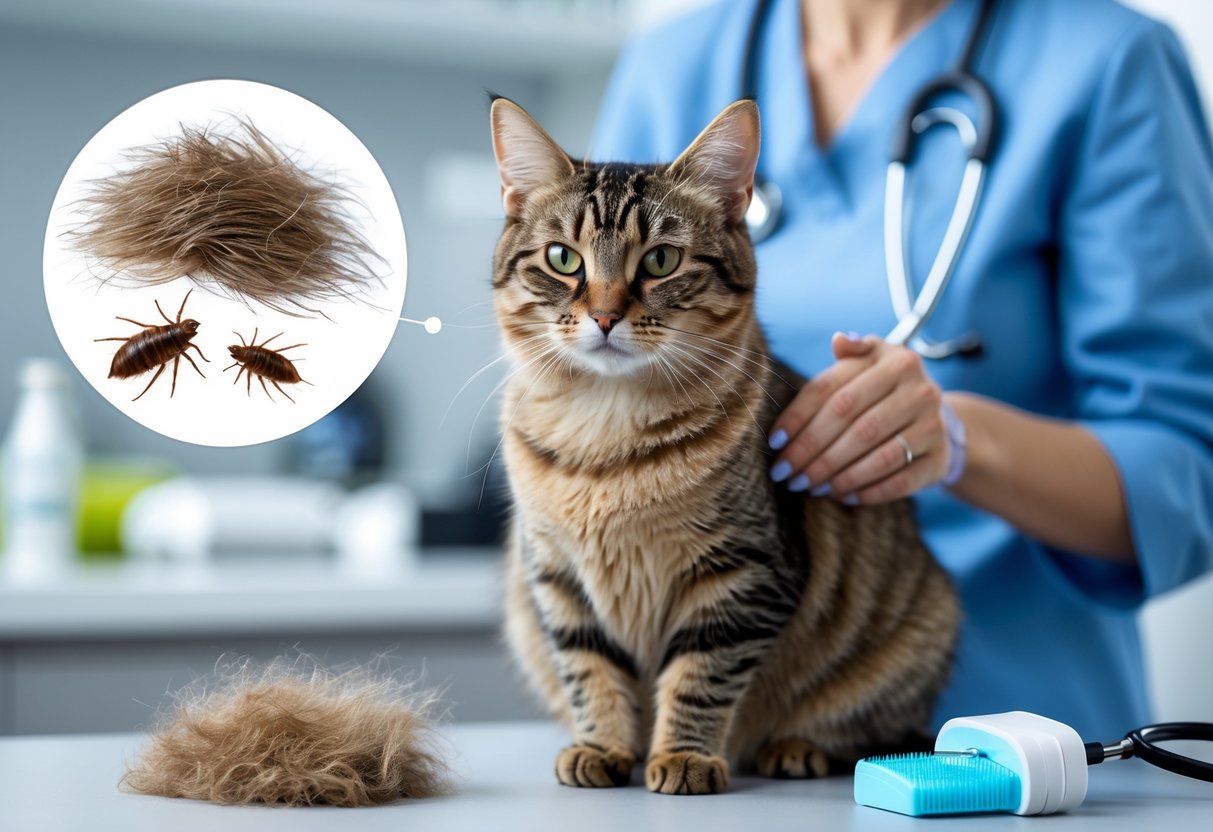
Ever notice your cat losing patches of fur? That can be pretty alarming. Cat hair loss usually means something’s off, but you can manage it once you know what’s going on.
Even if your cat seems perfectly fine otherwise, hair loss is a sign you shouldn’t ignore. Look for other symptoms, too—sometimes things aren’t as simple as they seem.
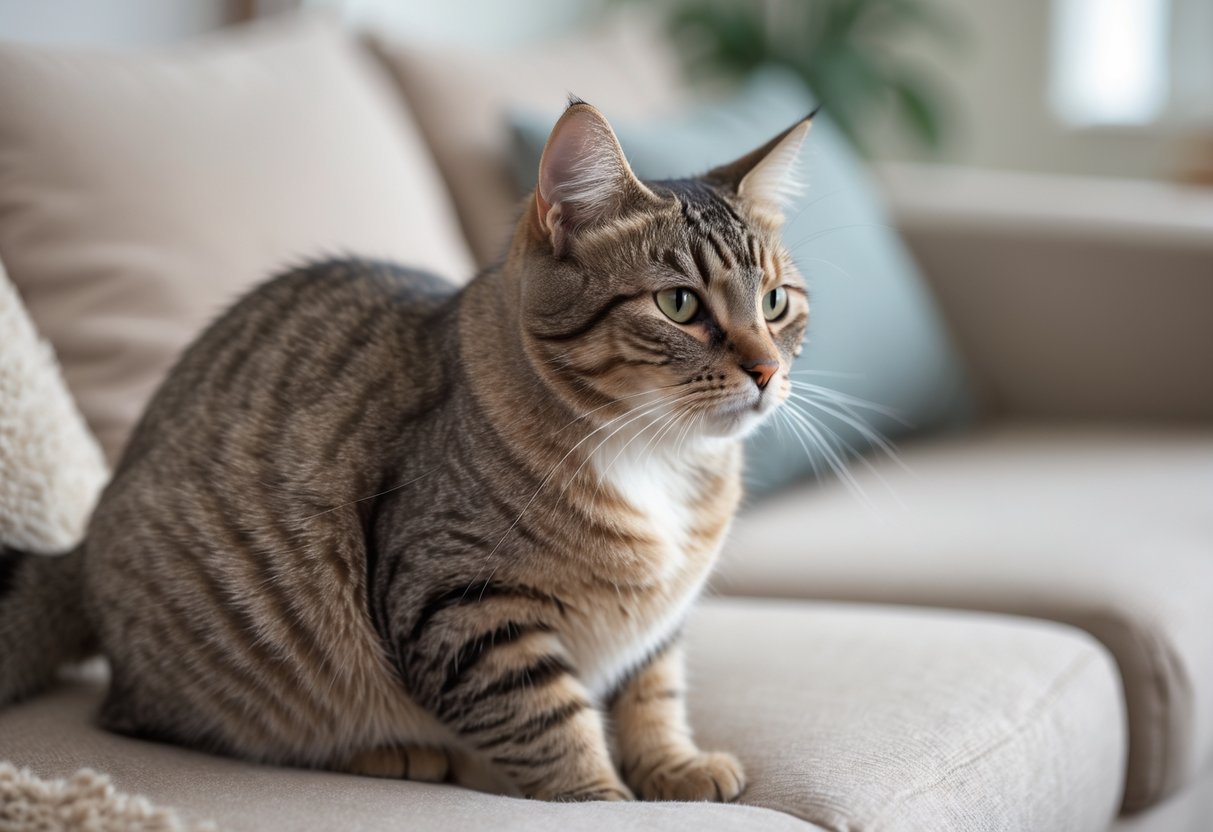
Allergies, skin infections, fleas, or even stress can make cats lose hair. Sometimes, it’s something more serious, like a hormone problem or a nutrition issue.
Spotting changes early really helps. Your cat will thank you for noticing.
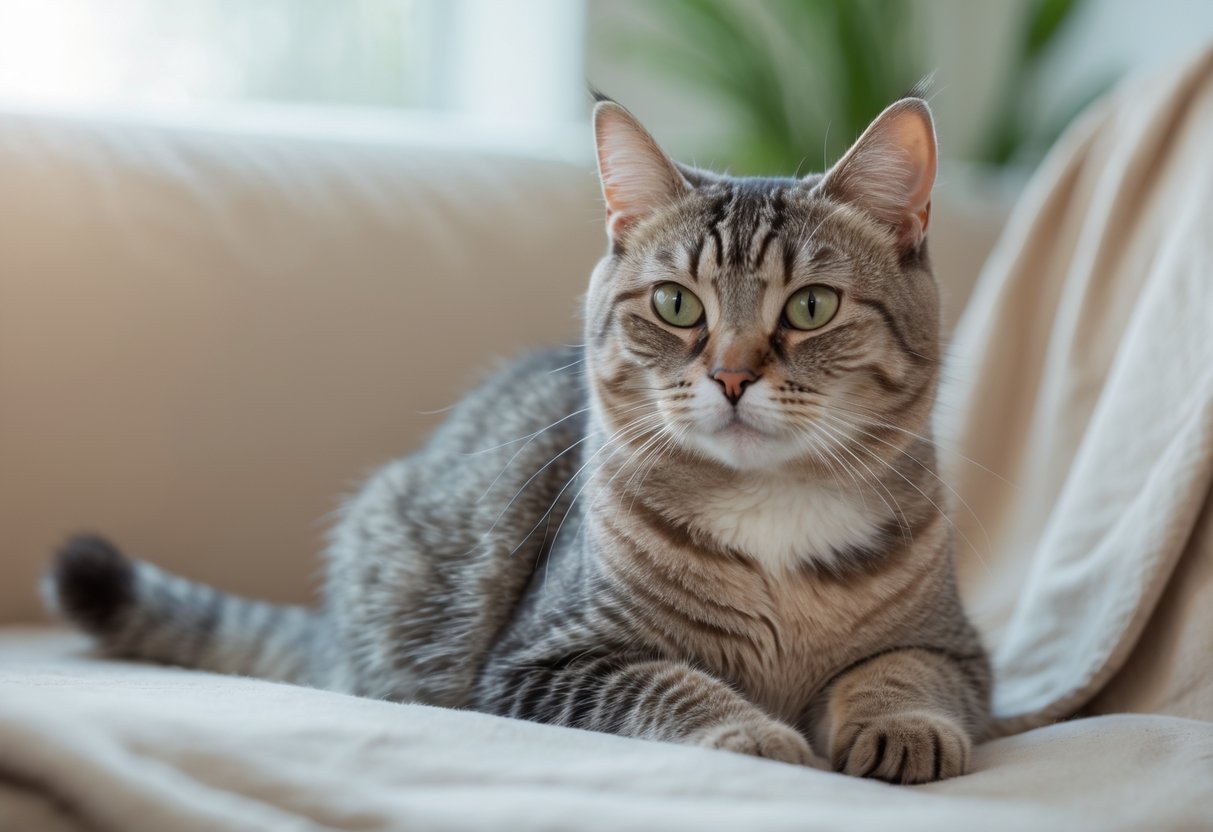
Cat hair loss means your cat is losing more fur than usual or has bald spots. Sometimes it’s just normal shedding, but it could be a skin condition called alopecia.
Knowing the difference helps you decide what to do next.
Cats can lose hair in a few different ways. The most common is gradual thinning, where fur just gets sparse in big areas.
Some cats get symmetrical patches of hair loss on both sides. Others have patchy hair loss—little bald spots here and there.
Complete baldness in small areas can mean a skin problem or an allergic reaction. Excessive grooming is another big cause—cats lick or scratch so much, the fur can’t keep up.
If you want to see what these patterns look like, check out pictures of cat hair loss.
Alopecia just means noticeable hair loss in cats. You might see thick clumps of missing fur, with exposed skin underneath.
This can show up anywhere—back, legs, belly, or near the tail. Allergies, stress, parasites like fleas or mites, fungal infections, and hormone problems can all cause alopecia.
Sometimes it’s genetics or a reaction to medication. Treatment depends on the cause—your vet might suggest special diets, medicine, or parasite control.
Some cases need long-term care, others bounce back in a few weeks. Here’s more about alopecia in cats.
All cats shed, especially when the seasons change. That’s totally normal, and you’ll see more hair on your sofa or clothes.
But excessive hair loss is different. If you spot bald patches, skin problems, or your cat looks itchy and miserable, it’s time to worry.
Major causes? Parasites, allergies, infections, and stress. If your cat seems sick or you notice these signs, call your vet.
For more on why cats lose hair and when to worry, check out the Fulton County Veterinary Clinic’s guide.

Lots of things can make cats lose hair. Knowing the main reasons helps you decide when to call your vet and what you can do at home to help.
Fleas and mites are probably the top parasites that cause hair loss in cats. When fleas bite, your cat gets itchy and starts scratching, biting, or overgrooming—bald patches follow pretty fast.
Some cats are super allergic to flea bites, so even one bite can drive them nuts for weeks. Fleas love the tail, back, and neck. Mites, like mange, burrow into the skin and make things even worse.
Look for scabs, red spots, or thinning fur. Keep your cat on parasite prevention and use prescription flea treatments to lower the risk.
More about hair loss and parasites in cats if you’re curious.
Allergies are another huge reason cats lose hair. Common culprits? Certain foods, pollen, dust, and flea saliva.
Environmental allergies, like grass or trees, can also make your cat itchy. When allergies hit, you’ll notice more grooming, licking, and scratching—bald patches usually show up on the belly, sides, or feet.
If you suspect food allergies, your vet may suggest changing what your cat eats. For environmental stuff, they might recommend meds, supplements, or tweaks at home to cut down on triggers.
Want details? Here’s more on how allergies can cause hair loss in cats.
Skin infections are a big deal for hair loss, too. Ringworm (which is a fungus, not an actual worm) is pretty common—look for circular bald spots with scaly or red edges.
Kittens and cats with weak immune systems get these more often. Bacterial skin infections can pop up if your cat scratches or bites too much, damaging the skin.
Watch for red, swollen, or hot areas that might ooze. Left untreated, infections can spread and cause more hair loss.
Treatment usually involves antifungal or antibiotic meds. Regular grooming and a clean living space can help a lot.
Read more about feline skin infections and hair loss if you want the nitty-gritty.
Sometimes, hormones mess up your cat’s fur. Diseases like hyperthyroidism or Cushing’s can cause clumps of hair to fall out, or make new fur grow super slowly.
You’ll often see other things, like weight loss, weird appetite, or thirst. Fur might look thin, dull, or patchy, especially around the sides, belly, or tail.
Your vet will probably need blood tests and a full checkup to diagnose this. Treating the disease usually helps the fur come back.
Want to dig deeper? Here’s more on how hormonal issues cause hair loss in cats.
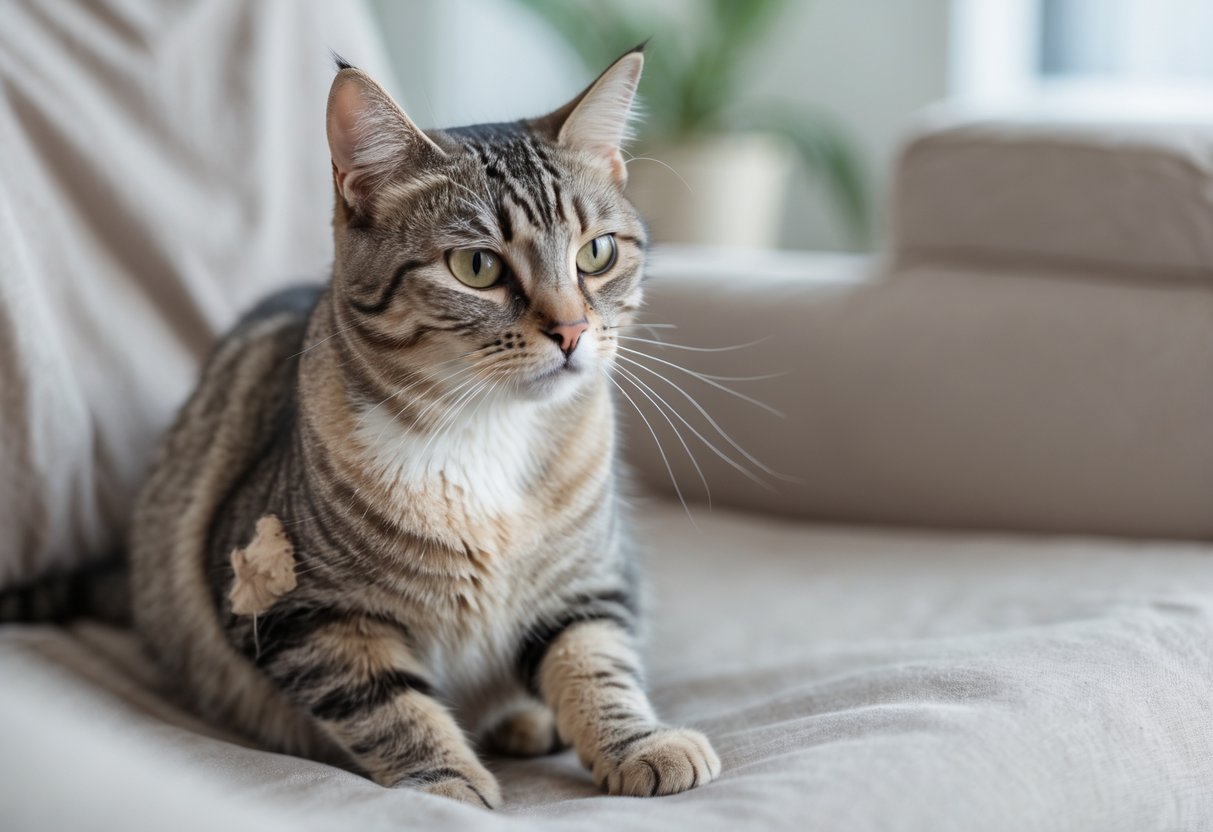
Skin conditions cause a lot of cat hair loss. Dermatitis and fungal infections hit the hair follicles, leading to bald spots, scabs, and irritation.
Dermatitis basically means skin inflammation. Allergies, parasites, or even certain foods can trigger it.
Look for redness, swelling, bumps, or sores. Some cats scratch so much, hair falls out even faster.
Flea allergy dermatitis is super common. Just one flea bite can make a cat itch like crazy.
Contact dermatitis happens when something your cat touches (like chemicals or certain litter) causes a reaction. If things don’t improve, your vet might suggest a skin biopsy to figure out what’s really going on.
Treating the cause is what gets the hair growing back. For more, check this detailed guide on cat skin problems.
Ringworm is a fungus that spreads easily—cat to cat, or even to people. You’ll see round, bald patches with flaky or crusty skin, usually on the head, ears, or paws.
Other fungal infections can look similar, with hair loss, itching, and scaly skin. Some are mild, others need special antifungal meds.
Vets can use a special light or do tests (like a skin biopsy) to confirm ringworm. Treat early to keep it from spreading everywhere.
More info on fungal skin infections at hair loss in cats: causes, symptoms, and treatment.
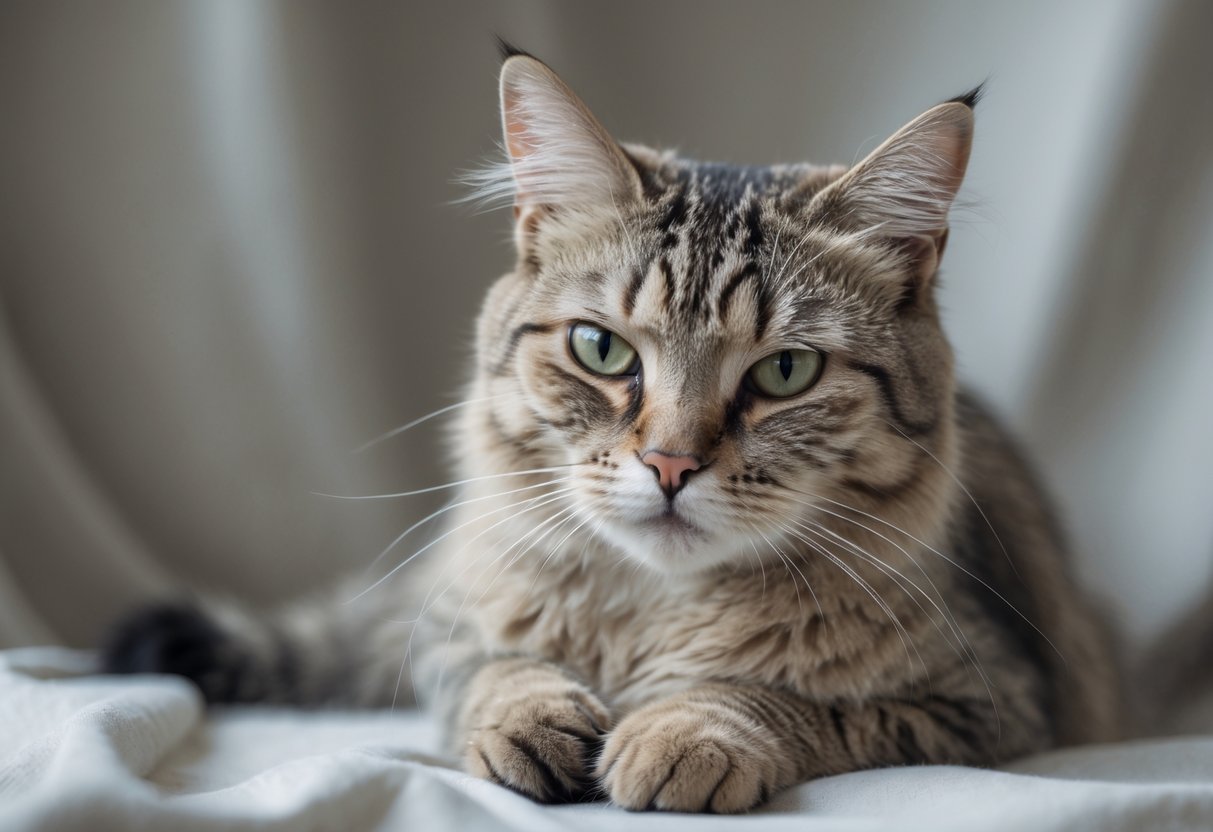
What your cat eats really matters for their skin and coat. The right nutrients mean a soft, shiny coat and healthy skin.
If your cat’s food is missing key stuff, you’ll see dry fur, bald patches, and itching. It’s not just about filling the bowl—quality counts.
Cats need protein, fatty acids, vitamins, and minerals for healthy fur. Protein helps fur grow strong, while omega-3 and omega-6 fatty acids keep skin shiny and flexible.
Vitamins like vitamin A and B vitamins support skin cell growth. Minerals like zinc and copper are important, too—without enough zinc, cats can get scaly skin and hair loss; low copper makes the fur dull and patchy.
Feed a complete, balanced diet. Cheap commercial foods or poorly balanced homemade meals can lead to skin and hair problems fast.
Want to know more about which nutrients help? Check out VCA Animal Hospitals.
Watch for warning signs that show your cat isn’t getting what they need. These may show up as:
Even a small shortage of nutrients can quickly lead to visible changes in your cat’s coat. Cats missing enough protein, zinc, or vitamin A might lose fur or have skin issues before you know it.
If you spot these problems, try adjusting your cat’s food or call your vet for advice. There’s more about poor nutrition’s effects at Pets Best.
Not all cat hair loss comes from medical problems. Sometimes, daily stress or repetitive habits can cause excess shedding or bald patches.
Sorting out these behavioral causes can really help your cat feel better.
Cats are pretty sensitive to changes around them. Moving homes, new pets, or even loud noises can make them anxious.
When stress hits, lots of cats start licking or chewing their fur more than usual. Over time, this nervous grooming leaves bald spots—especially on the belly, legs, or sides.
If you notice these, try to keep your cat’s routine as calm as possible. Toys, cat trees, and quiet spots to hide can help your cat relax and avoid excessive hair loss from stress.
Some cats develop compulsive grooming, called psychogenic alopecia. This goes way beyond regular cleaning—cats might lick, bite, or chew the same spots for hours.
Here’s what to watch for:
| Symptom | Description |
|---|---|
| Consistent bald spots | Usually on belly, inner thighs, or legs |
| Skin irritation | Red, raw, or inflamed skin |
| Odd grooming behavior | Licking or biting even without dirt or parasites |
Unlike normal grooming, you’ll see clear patterns and more severe hair loss caused by excessive grooming. Medical issues can look similar, so check with your vet first.
If health problems are ruled out, ask your vet about ways to lower your cat’s anxiety and help break the habit.
To figure out why your cat is losing hair, your vet will use a few key steps. Careful exams and the right tests can pinpoint the cause.
Your vet checks your cat’s skin, fur, and overall health. They’ll look for redness, scaling, thickened skin, or bald spots.
They’ll ask about your cat’s medical history. Be ready to share details about changes in behavior, diet, grooming habits, and when you first noticed hair loss.
Physical exams often include checking for fleas or mites. Flea combs and skin scrapes help spot these pests.
The vet will also compare both sides of your cat’s body, since some causes create symmetrical hair loss.
If the exam doesn’t give a clear answer, your vet will probably run lab tests. Skin smears and cultures can check for bacterial, fungal, or yeast infections.
If things still aren’t clear, your vet might suggest a skin biopsy. Blood and urine tests can help spot hormone problems or other hidden issues.
Sometimes, allergy testing or thyroid tests are needed. Lab work lets your vet figure out what’s really going on and recommend the best treatment.
For more on these steps, see how vets use exams and lab tests to diagnose hair loss in cats.
Treating cat hair loss means figuring out what’s causing it and using a mix of medical care and changes at home. With the right steps, your cat’s fur will usually grow back.
Alopecia in cats can come from parasites, allergies, infections, stress, or hormone issues. Your vet will check your cat’s skin, run tests, and look for fleas, mites, fungus, or signs of allergies.
Treatment depends on the cause. For example:
If stress or anxiety is the problem, your vet might suggest medicine like fluoxetine or calming supplements. There’s more about these treatments for cat hair loss if you’re curious.
At home, regular brushing and the occasional bath help keep your cat’s skin healthy and remove loose fur. Feed a diet with enough protein and omega-3s for a shiny coat.
Gentle baths with hypoallergenic shampoos can soothe irritated skin. Try to keep your home calm and offer toys or scratching posts for enrichment.
Pheromone sprays or diffusers may help anxious cats feel safer. Watch for over-grooming or sudden changes in grooming habits.
If you see bald spots, redness, or sores, call your vet right away. There’s more advice for home treatment of cat hair loss online.
Knowing when to take your cat to the vet can make a big difference for their skin and coat. Sometimes hair loss is minor, but it can also mean something serious is going on.
If your cat’s hair loss doesn’t get better in a week, or you see red, inflamed skin, call your vet soon. Watch for constant itching, sores, scabs, or if your cat keeps licking or biting the same spots.
Notice any big behavior changes? If your cat seems tired, hides more, eats less, or is drinking or peeing much more than normal, these could be red flags.
Sudden weight loss, swelling, or pain near bald areas also need quick attention. If bald patches spread fast or wounds won’t heal, don’t wait—get your cat checked right away.
Find more advice about when to get help for cat hair loss.
Cat hair loss can come from all kinds of things—stress, allergies, parasites, or health problems. Knowing what’s normal and what needs a vet visit can help you look out for your cat.
Worry if your cat is losing hair in patches, develops bald spots, or if the skin looks red, swollen, or has sores. Extra scratching, biting, or licking, especially with sudden or severe hair loss, are signs to watch for.
If you notice these, it’s usually best to see your vet. Hair loss in cats is rarely normal and could mean allergies, pain, or infection.
Keep your cat’s fur brushed and clean to remove loose hair and prevent mats. Sometimes, regular baths with gentle cat shampoo help, but check with your vet first—over-bathing can make things worse.
Try to reduce stress, keep up with flea treatments, and make sure your cat has a safe, quiet space. If the hair loss keeps going or gets worse, a vet appointment is necessary.
A poor diet can make fur dull and increase shedding. Cats need protein, fat, vitamins, and minerals for healthy coats.
Deficiencies—like not enough omega-3 or omega-6 fatty acids—can make hair loss worse. If you’re not sure about your cat’s food, ask your vet or check out more about fur health and nutrition.
Treatment depends on what’s causing it. If it’s fleas or mites, your vet might prescribe flea meds. For allergies, a food change or itch medicine may help.
Fungal infections like ringworm need oral or topical meds. Reducing stress, treating skin infections, and addressing pain are other options your vet might suggest. More treatment options are explained here.
Yes, sometimes hair loss is linked to thyroid problems, hormone changes, autoimmune diseases, or even cancer. Older cats might develop bald patches for age-related reasons or illness.
If you see sudden or severe hair loss, get your cat checked to rule out serious conditions. Read more about hair loss and health conditions in cats.
Flea allergies, ringworm, and mite infestations show up a lot in cats. Dermatitis pops up too—basically, that’s skin inflammation, and it usually happens because of allergies to food or something in the environment.
a
[…] and dirt, which can cut down on the risk of hairballs and reduce the likelihood of skin problems or cat hair loss. Consistent grooming also spreads skin oils, keeping the coat healthy and […]
Great points, and thank you for sharing! A nutritious diet and consistent grooming are definitely key elements in supporting a cat’s immune health. I’m glad you highlighted the importance of these daily habits — they truly make a difference!